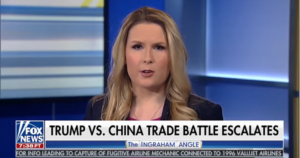Oct
6
Answering Common Questions Re U.S. Trade with China
I haven’t been keeping up on the topic of President Trump’s trade wars. I’m no economist, but I remember enough to know that the imposition of tariffs is generally not a good idea, as it’s the consumer that pays the (higher) price. So, this is one of those areas where I think Trump is making “unforced errors”, and I don’t enjoy trying to follow the story of his trade dealings, especially where China and Mexico are concerned.
However, I started poking around in the last few weeks’ worth of news and came across a helpful Special Report (from April 2019) put together by Tori Whiting and Gabriella Beaumont-Smith, up-n-coming economists at the Heritage Foundation: “11 Common Questions About U.S. Trade with China”. If you don’t want to read the whole article or just aren’t sure yet, allow me to give you the short version:
Q1) Has America Lost Thousands of Jobs to China?
Short Answer: America has not lost net jobs due to trade with China, or with any other country. Employment in the manufacturing sector has decreased by roughly 4.8 million jobs since 1999. However, it is nearly impossible to draw a direct causal relationship between these employment figures and China’s accession to the WTO in 2001. Plus, those Americans working in manufacturing are now more productive than before.
Q2) Is Manufacturing in America Dead?
Short Answer: No. A look at real manufacturing output in the U.S. (see Chart 3 in full report) demonstrates that Americans produce a remarkable amount of manufactured goods. Since 1999, real manufacturing output has increased by more than $220 billion.
Q3) Is China Dumping Steel into the U.S. Market?
Short Answer: There are U.S. laws on the books that establish a process to determine whether an import is being dumped or subsidized. Many imports of steel products from China have been found to be dumped or subsidized, and additional tariffs have been applied for a short period of time. But, steel imports from China represent only about 3.4 percent of all U.S. steel imports.
 Q4) Can America Win a Trade Dispute?
Q4) Can America Win a Trade Dispute?
Short Answer: The President has argued that “trade wars are good and easy to win,” and that, because China relies on the U.S. economy for its exports, it will back down when threatened with tariffs. However, when the U.S. increases or adds tariffs to Chinese goods and China retaliates in return, they only hurt American and Chinese individuals, families, and businesses.
Q5) Does the Trade Deficit Mean that the U.S. Owes China Money?
Short Answer: Maybe, but that doesn’t mean we’re “losing” at trade. There is too much focus on the ‘current account’ deficit (i.e., re the flow of goods and services) while neglecting the ‘capital account’ surplus (i.e., re the flow of financial transactions). America imports more than it exports, but Chinese companies and investors have also greatly increased their investment in American businesses. This type of investment results in a capital account surplus, which counteracts the current account deficit (the trade deficit) and illustrates America’s growth and attractiveness to investors.
Q6) Does China Need Us More Than We Need Them?
Short Answer: To assume that the answer is “yes” fails to take into account all of the evidence from Answer #5, which shows that trade with China is mutually beneficial. Furthermore, it fails to acknowledge the growth in the number of American jobs tied to trade with China.
Q7) Does China Still Have High Trade Barriers?
Short Answer: It is true that China has higher tariff barriers than the United States, and in many cases the non-tariff barriers are also higher. However, this fact alone does not take into account the significant progress that has taken place to lower China’s tariff barriers…. When compared to other top trading partners of the U.S., China’s average tariff rate lands somewhere in the middle of the pack…. While China has many burdensome non-tariff barriers, it is difficult to measure those barriers. Any remaining trade restrictions in China affect the freedom of Chinese people and businesses more than any other country…. So far, the Trump Administration’s efforts to force China to reduce these barriers, many of which occur in the form of government subsidies, have been unsuccessful.
 Q8) Is the World Trade Organization Effective Against China?
Q8) Is the World Trade Organization Effective Against China?
Short Answer: Rather than hold China accountable via the WTO for violations of their international obligations, the Trump Administration has imposed tariffs on more than $250 billion worth of Chinese goods. However, the U.S. has won 100 percent of the cases it has litigated at the WTO against China since 2004. In these situations, China has complied with dispute outcomes in all cases but one, where China partially complied. The WTO process works for America, and the Trump Administration should continue to pursue disputes through this channel as needed.
Q9) Is it in China’s Interest to Sell Off Large Amounts of Its Foreign Exchange Reserves?
Short Answer: No. When finished goods are exported to the U.S., American firms pay Chinese exporters in U.S. dollars. Some of those dollars end up in China’s central bank, which stockpiles them in its foreign exchange reserves. Due to the dollar’s popularity, these reserves reassure foreigners who invest in the Chinese economy. Also, China’s economy depends on trade, and it needs a large reserve of dollars to serve as a type of insurance. During emergencies, such as natural disasters, national currency devaluation, or in the worst case, currency insolvency, China has dollars reserved so that it can continue to trade. Thus, it is not in China’s interest to sell off large amounts of its foreign exchange reserves, because it would lose the insurance that said reserves provide.
Q10) Can China Use Its U.S. Debt Holdings as a Trade Weapon?
Short Answer: China’s ownership of U.S. debt does not give it leverage over the United States because “American debt is a widely held and extremely desirable asset in the global economy.” If China offloaded significant amounts of the debt, it would reduce the value of China’s remaining dollar holdings, negatively affect the renminbi exchange rate, and quickly be purchased by other countries. Aggressively offloading foreign debt can be disruptive to the debt-owner’s economy, because of its importance in trade relations.
Q11) Is China’s Economy Bigger than the U.S. Economy?
Short Answer: The claim is that China’s GDP was about $21 trillion (after adjusting for inflation) in 2017, thereby surpassing the U.S. But, China’s economy is not as big as often advertised, because of the use of purchasing power parity (PPP) exchange rates. The PPP method shows China’s GDP as if China had the same cost of living as the United States, which it does not. To compare the sizes of the economies, it is better to use the regular market exchange rates. This method adjusts for standards of living by simply converting China’s GDP in yuan to U.S. dollars the same way that people convert their currency when they visit another country. When using exchange rates, China’s real GDP is calculated to have been around $14 trillion in 2017, not $21 trillion.
The authors conclude,
“Trade is not a zero-sum game. The freedom to trade with China is important for the American people because it increases competition, innovation, and choice in the marketplace. The trade discussion is often polluted with hyperbole and rhetoric, making it more important than ever to be equipped with the facts and supporting data. The questions answered in this Special Report should help to guide policy to increase trade liberalization so that both American and Chinese individuals and families can enjoy greater levels of economic freedom and prosperity.”
I admit, I am still a bit uncomfortable with a large communist nation having so much interdependence with the U.S. economy, and I don’t necessarily trust them to make wise economic decisions. (They are communist, after all, where ideology and control of the people is paramount.) But, this report was helpful in better understanding the real situation.
The full Special Report, of course, has more details, a glossary of trade terms, and charts based on data from the Bureau of Labor Statistics, U.S. Department of Commerce, Bureau of Economic Analysis, The World Bank, International Monetary Fund, etc. If you are into this stuff, you should definitely check it out.

















